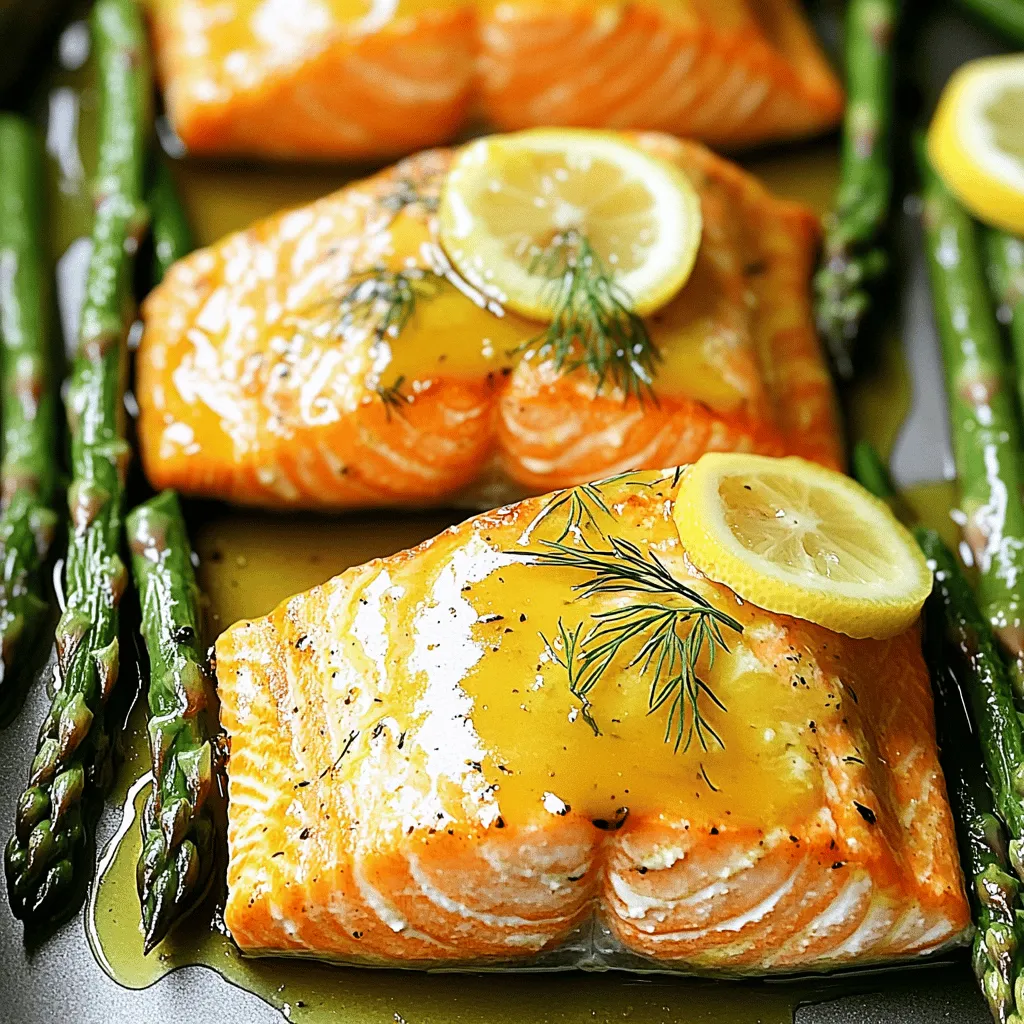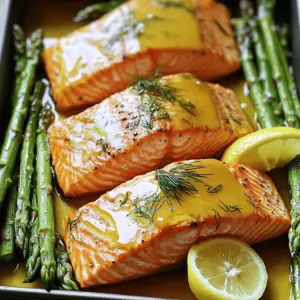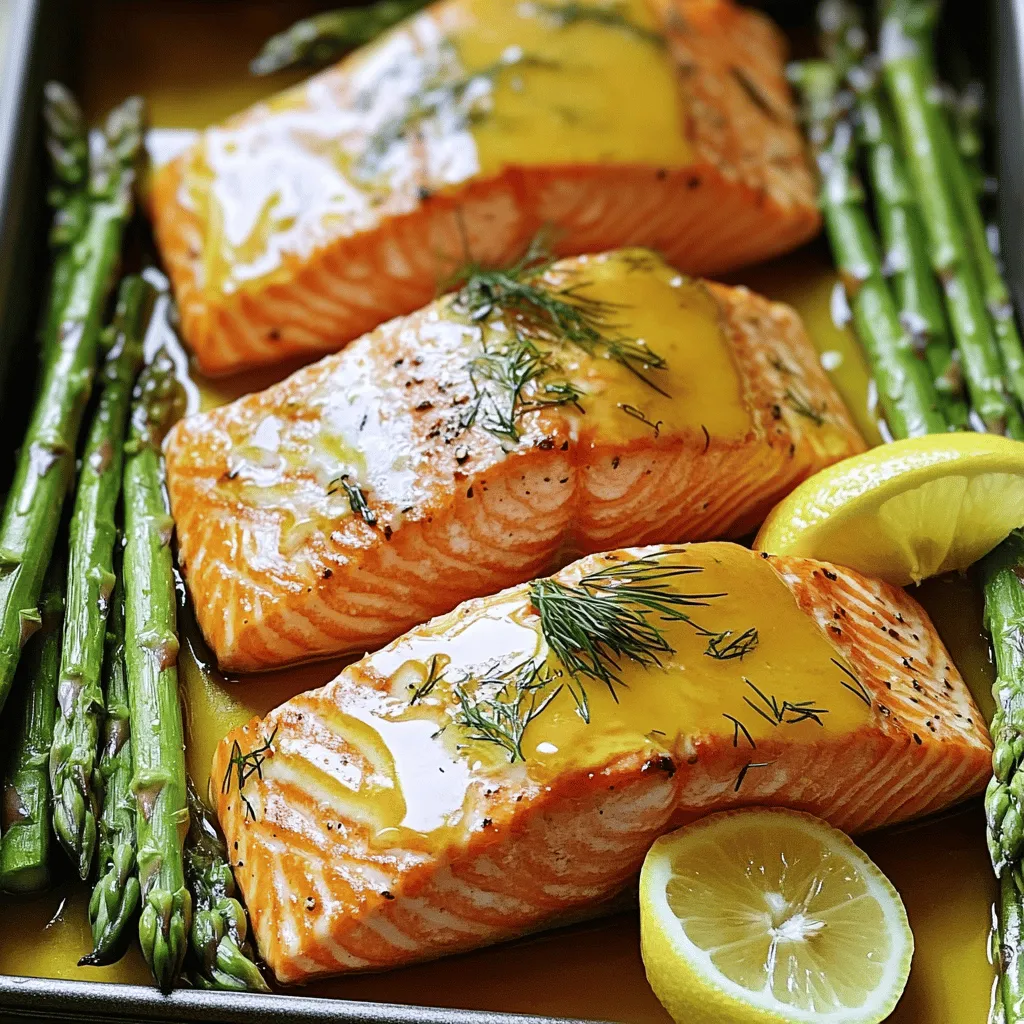Ready for a flavor-packed meal? This Lemon Dijon Salmon with Asparagus is a treat for your taste buds! With fresh salmon, crisp asparagus, and a zesty Dijon honey glaze, you can impress anyone at your dinner table. I’ll guide you step-by-step through this easy recipe, ensuring every bite bursts with delightful taste. Let’s dive into the ingredients and make your next meal a memorable one!
Ingredients
Main Ingredients for Lemon Dijon Salmon
– 4 salmon fillets
– 1 bunch asparagus, trimmed
– 3 tablespoons Dijon mustard
– 2 tablespoons honey
Additional Ingredients
– 2 tablespoons olive oil
– 2 cloves garlic, minced
– Zest and juice of 1 lemon
Seasoning and Garnish
– Salt and pepper to taste
– Fresh dill or parsley for garnish
When making Lemon Dijon Salmon, you need fresh salmon fillets. Choose fillets that are bright and firm. Look for a nice pink color and avoid any discoloration. The asparagus should be bright green and crisp. Trim the ends for the best texture.
The Dijon mustard gives a tangy flavor that pairs well with honey’s sweetness. This mix brings a lovely balance to the dish. Olive oil adds richness and helps the salmon stay moist. Minced garlic packs a punch and brings warmth to each bite.
Lemon zest and juice brighten the whole dish. They add a fresh taste that makes the salmon shine. A sprinkle of salt and pepper brings out all the flavors. Fresh dill or parsley makes a lovely garnish. It adds a pop of color and herbal notes that enhance the meal.
Gather these ingredients, and you are ready to create a flavorful delight!
Step-by-Step Instructions
Preheat and Prepare
First, preheat your oven to 400°F (200°C). This step helps the salmon cook evenly. Next, grab a baking dish. You want one that fits your salmon fillets well. Lightly grease it with some olive oil to avoid sticking later.
Making the Dijon Honey Mixture
In a small bowl, whisk together the Dijon mustard, honey, olive oil, minced garlic, lemon zest, and lemon juice. Mix until all the ingredients blend nicely. The mixture should be smooth and a bit runny. If it feels too thick, add a touch more olive oil. This sauce gives the salmon a great flavor.
Arranging Ingredients
Now it’s time to season the salmon. Sprinkle salt and pepper on both sides of each fillet. Place them in your prepared baking dish. Next, spread the Dijon honey mixture on top of each fillet. Then, take the trimmed asparagus and arrange it around the salmon. Drizzle some olive oil over the asparagus and sprinkle it with salt and pepper.
Baking Process
Put the dish in your preheated oven. Bake for 12-15 minutes. Keep an eye on it. The salmon should flake easily with a fork when it’s done. The asparagus should be tender but not mushy. If you want to be sure it’s cooked, you can check with a fork or a thermometer. The ideal internal temperature for salmon is 145°F (63°C).
Tips & Tricks
Perfecting the Salmon
When choosing salmon, look for bright, shiny skin. The flesh should feel firm and spring back when pressed. Avoid salmon with a dull color or a strong fishy smell. For cooking, you can grill or pan-sear salmon if you want a crisp skin. These methods add great flavor and texture.
Asparagus Preparation
To trim asparagus, hold each spear and bend it until it snaps. This point is where the tough part ends. Discard the woody ends, and keep the tender parts. For tender asparagus, cook it until bright green and just tender. A quick steam or sauté works well to maintain its crunch.
Flavor Enhancements
To amp up the flavor, add spices like paprika or fresh herbs like thyme. These will give your dish a new twist. If you want to change the marinade, try using a sweet soy sauce or a spicy chili paste. These options can give your salmon a whole new taste experience.

Variations
Ingredient Substitutions
What are good alternatives to salmon?
If you want to switch it up, you can use other fish like trout or cod. Both have a mild taste that pairs well with lemon and mustard.
What different vegetables can I use?
You can swap asparagus for green beans, broccoli, or zucchini. Each adds a unique flavor and texture to the dish.
Flavor Profile Changes
What happens if I use different mustards?
You can use whole grain mustard for a crunchier texture. Yellow mustard works too, but it has a milder taste.
What sweetener options can I try?
Instead of honey, you can use maple syrup or agave nectar. This will change the flavor but keep it sweet.
Cooking Techniques
Can I grill instead of bake?
Yes! Grilling gives the salmon a smoky flavor and nice grill marks. Just cook it for about 6-8 minutes on each side.
What skillet methods can I use?
You can pan-sear the salmon in olive oil over medium heat. Cook it for 4-5 minutes per side for a crispy outside.
Storage Info
Proper Storage Techniques
After cooking Lemon Dijon Salmon with Asparagus, let it cool first. Place the leftovers in an airtight container. This helps keep the salmon and asparagus fresh. Store it in the fridge if you plan to eat it soon.
For longer storage, you can freeze the leftovers. Wrap the salmon and asparagus tightly in plastic wrap. Then, put them in a freezer-safe bag. This will help prevent freezer burn.
Reheating Instructions
When reheating salmon, it’s best to do it gently. Preheat your oven to 350°F (175°C). Place the salmon on a baking sheet. Cover it with foil to keep it moist. Heat for about 10-15 minutes. Check if it’s warm throughout.
For asparagus, you can place it in the microwave. Heat in short bursts. This way, you won’t overcook it. You want it to stay crisp, not mushy.
Shelf Life
Leftovers can last in the fridge for about 3 days. Make sure to check for signs of spoilage. If it smells off or looks discolored, it’s best to toss it out.
In the freezer, the salmon can stay good for up to 3 months. Keep an eye on it for freezer burn. If you see ice crystals, it’s time to use it or discard it.
FAQs
What can I serve with Lemon Dijon Salmon?
You can pair Lemon Dijon Salmon with a variety of side dishes. Here are some tasty options:
– Rice: Jasmine or basmati rice works well.
– Quinoa: This adds a nice nutty flavor.
– Mashed Potatoes: Creamy mashed potatoes balance the dish.
– Salad: A fresh green salad adds crunch and color.
– Roasted Vegetables: Carrots or bell peppers complement the salmon.
For drinks, a light white wine or sparkling water is great.
Can I use other fish instead of salmon?
Yes, you can use mild fish like:
– Tilapia: It cooks quickly and has a light flavor.
– Cod: This fish has a flaky texture and holds up well.
– Trout: It has a rich taste and pairs nicely with lemon.
When using these fish, adjust cooking times. Cook tilapia and cod for about 10-12 minutes. Trout can take around 12-15 minutes.
How do I know when the salmon is fully cooked?
To check if your salmon is done, look for these visual cues:
– The salmon should change from translucent to opaque.
– It should flake easily with a fork.
The ideal internal temperature for salmon is 145°F (63°C). Use a meat thermometer for accuracy. This ensures your meal is safe and tasty.
This post covered a simple, tasty Lemon Dijon Salmon recipe. We explored important ingredients like salmon, asparagus, Dijon mustard, and honey. I provided clear steps for baking and added tips for freshness and flavor. You can also try variations with different fish or cooking methods.
Remember, store leftovers properly for later enjoyment. With these insights, you can create a delicious meal for any occasion! Enjoy the cooking process and share this recipe with others who love good food.

